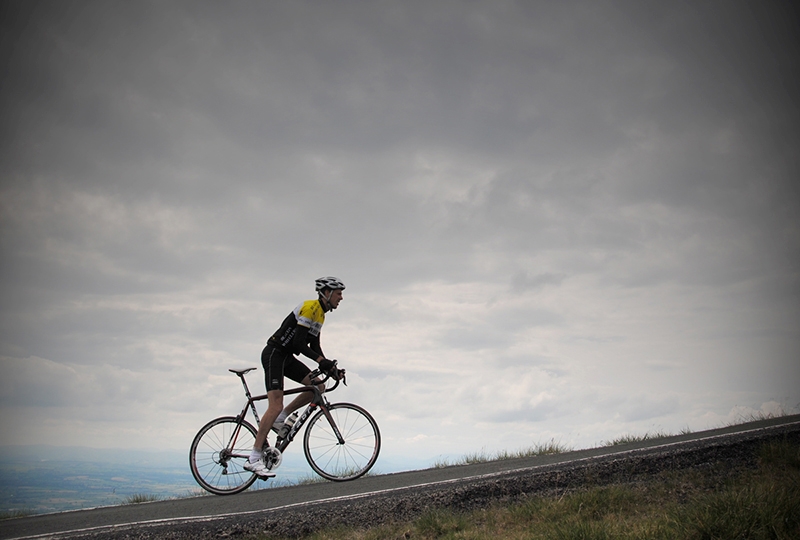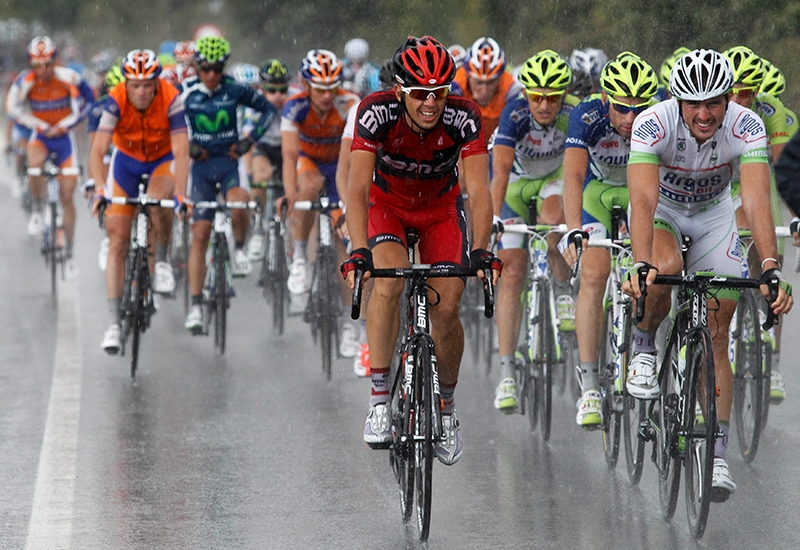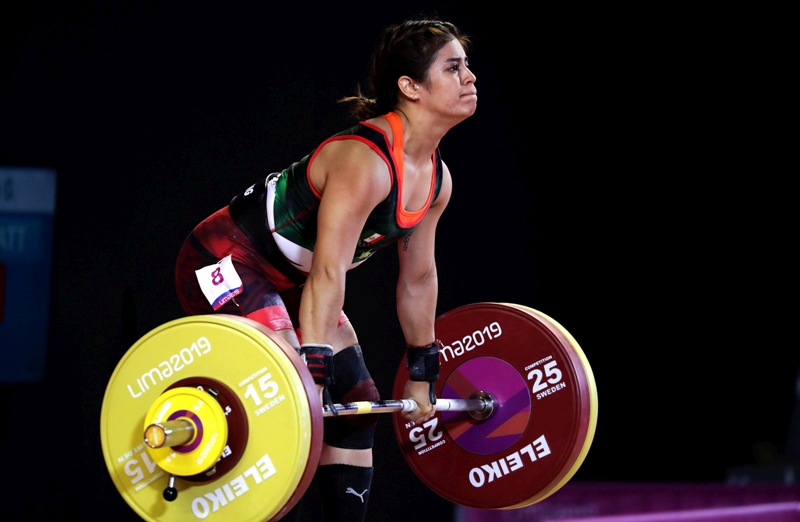You are viewing 1 of your 1 free articles. For unlimited access take a risk-free trial
The power and the glory: what all athletes need to know about power-to-weight ratio

Using cycling as an example, Andrew Hamilton explains the performance relationship between outright power and power-to-weight ratio, and how to get better when the terrain point upwards...
One of my oldest friends is an avid petrolhead who builds and races cars for a living. He often jokes: ‘Money can’t buy you happiness, but it can buy you more horsepower – and that’s the same kind of thing!’ As much as many athletes would like to, it’s not possible to buy more power (well, not legally anyway). To enable the muscles to produce more power, you have to perform specific training sessions such as interval training over an extended period of time, which requires significant effort and commitment. And while improving your endurance fitness can significantly increase the amount of power your muscles can produce, basic human physiology means there’s a limit to the gains that can be achieved this way.Fortunately however, the absolute amount of power at your disposal is not the only factor for determining performance. The amount of mass you have to move around – ie your bodyweight – is vitally important too. This is because accelerating mass or moving mass uphill against the force of gravity requires power. It follows therefore that if you have less mass to lug around, you need less power to move it against gravity – a concept which leads to the notion of ‘power-to-weight ratio’.
Cycling, power and weight
Power-to-weight ratio is an important determinant of performance in a range of sport where athletes work against gravity – for example X-country skiers, runners and in fact any sport which involves running. That’s because each stride taken when running involves an ‘up and down’ motion, requiring the muscles to work against and overcome the force of gravity. However, nowhere is the relationship between power and power-to-weight ratio more important than in the sport of cycling.For most cyclists who don’t ride on perfectly flat and smooth roads (ie virtually every road and off-road cyclist), what matters just as much as maximum power output is the amount of power that can be produced in relation to bodyweight – ‘power-to-weight ratio’ – usually expressed in watts per kilogram. To work out a power-to weight ratio figure, simply divide your maximum sustainable power output (in watts) by your body mass in kilograms (kg). For example, an 80kg rider with a maximum sustainable power output of 280 watts has a power-to-weight ratio of 3.5 watts per kilo (commonly abbreviated as 3.5W/kg or 3.5W.kg-1).
Power-to-weight ratio matters because it’s a great predictor of performance. Take two cyclists; cyclist A can sustain a maximum power output of 250 watts while cyclist B can only manage 225 watts. On a perfectly flat, smooth indoor track (where gravity is not an issue) we can confidently predict that A will be faster than B because more available power means more power to overcome air resistance resulting in a higher average speed. On an undulating road however, power-to-weight ratio begins to matter more. If both cyclists weigh 80kgs, A will still be faster. But if A weighs 80kgs and B weighs 68kgs, cyclist A’s power-to-weight ratio is 3.13 watts/kg while B’s is 3.31 watt/kg.
On a flat road, there might not be much in it but head into the hills and it is cyclist B that will be pulling away! That’s because as the gradient increases, the relative contribution to the total energy required from overcoming gravity grows steadily. At the surface of the earth, gravity exerts a force on any mass of approximately 10 Newtons per kilo. A Newton of force applied through a distance of 1 metre requires a joule of energy. So if a rider weighs an extra 10kgs and climbs a hill that is 500m (1650ft) high, the simple laws of physics dictate that he or she will expend an extra 500 x 10 = 5000 joules of energy compared to a lighter cyclist.
Because energy is derived from oxygen metabolism, it follows that this extra 5000 joules of energy has to be generated from an increase in oxygen consumption. Since a litre of oxygen delivered to the muscles can generate around 21,000 joules of energy, this implies the extra oxygen demand is around a quarter of a litre – ie around 250mls. But this assumes that 100% of the cyclist’s energy is used to overcome gravity. The reality is very different; studies suggest that cycling efficiency is only around 15%, with 85% of the oxygen consumed ‘wasted’ as heat(1).
When you factor in the 15% cycling efficiency, our cyclist has to consume around 7 x 250mls of extra oxygen to get his/her extra 10kgs of body mass up the hill. That’s an extra 1.75 litres of oxygen. If it takes 15 minutes to climb the hill, that’s an extra 116mls of oxygen that need to be consumed each and every minute over and above that required by our lighter cyclist – a significant amount!
Figure 1 below provides an excellent illustration of how, when the gradient increases, the balance shifts away from absolute power (needed to overcome air resistance) to power-to-weight ratio (needed when overcoming gravity). You can see how on the flat, a 75kg producing 300 watts of power expends the bulk (83%) of that power overcoming air resistance. No energy is required to overcome gravity. However, now look what happens at a very modest 6% gradient; here, no less than 80% of the cyclist’s energy is expended overcoming gravity, with just 10% used for overcoming air resistance. At a stroke, absolute power becomes far less important than power-to-weight ratio!
Figure 1: The relative energy contributions to overcome air resistance and gravity(2) (road bike, 300-watt power output)

NB: Assumptions for rider shown in box, lower RH corner. Typical expected speeds shown by blue line. The rolling resistance contribution (red) falls proportionately as speed falls whereas drivetrain losses remain fairly constant due to constant 300-watt power output. Data from Coggan et al ‘Validation of a Mathematical Model for Road Cycling Power’, J Appl Biomechanics 1998; 14:276-291(2)
Understanding power-to-weight ratio
Since power-to-weight ratio is determined by the simple formula power (watts) ÷ mass (kg), hopefully even the most non-mathematical readers can appreciate that there are 3 ways to increase your power-to-weight ratio:- Increase your power output while keeping your weight constant;
- Keep your power output constant while decreasing your weight;
- Increase your power output while also decreasing your weight.
Table 1: Power-to-weight ratio (watts/kg) for a range of rider weights and power outputs
| 120w | 150w | 180w | 210w | 240w | 270w | 300w | 330w | 360w | 390w | |
| 45kg | 2.7 | 3.3 | 4.0 | 4.7 | 5.3 | 6.0 | 6.7 | 7.3 | 8.0 | 8.7 |
| 50kg | 2.4 | 3.0 | 3.6 | 4.2 | 4.8 | 5.4 | 6.0 | 6.6 | 7.2 | 7.8 |
| 55kg | 2.2 | 2.7 | 3.3 | 3.8 | 4.4 | 4.9 | 5.4 | 6.0 | 6.5 | 7.1 |
| 60kg | 2.0 | 2.5 | 3.0 | 3.5 | 4.0 | 4.5 | 5.0 | 5.5 | 6.0 | 6.5 |
| 65kg | 1.8 | 2.3 | 2.8 | 3.2 | 3.7 | 4.1 | 4.6 | 5.0 | 5.5 | 6.0 |
| 70kg | 1.7 | 2.1 | 2.6 | 3.0 | 3.4 | 3.8 | 4.3 | 4.7 | 5.1 | 5.6 |
| 75kg | 1.6 | 2.0 | 2.4 | 2.8 | 3.2 | 3.6 | 4.0 | 4.4 | 4.8 | 5.2 |
| 80kg | 1.5 | 1.9 | 2.2 | 2.6 | 3.0 | 3.4 | 3.8 | 4.1 | 4.5 | 4.9 |
| 85kg | 1.4 | 1.8 | 2.1 | 2.5 | 2.8 | 3.2 | 3.5 | 3.9 | 4.2 | 4.6 |
| 90kg | 1.3 | 1.7 | 2.0 | 2.3 | 2.7 | 3.0 | 3.3 | 3.7 | 4.0 | 4.3 |
| 95kg | 1.2 | 1.6 | 1.9 | 2.2 | 2.5 | 2.8 | 3.2 | 3.5 | 3.8 | 4.1 |
Looking at table 1, notice how power-to-weight ratios rise as power output rises and bodyweight falls – ie higher and further to the right in this table. Notice too how any given power-to-weight ratio (we’ve highlighted 3 watts/kg) can be achieved at much lower absolute power outputs when the rider’s mass is low. For example, a 50kg rider churning out just 150 watts has the same power-to-weight ratio as a 90kg rider churning out 270 watts!
Now suppose this 90kg rider wants an improved power-to-weight ratio. If he/she sheds 10kg (down to 80kg), power-to-weight ratio jumps from 3.0 to 3.4 watts/kg – that’s a bigger improvement than staying at the same weight and working on aerobic fitness to increase power output to 300w! This underlines why shedding excess body mass (fat) is so effective at boosting performance in the hills – even if your aerobic fitness remains the same.
Panel 1: Testing your own power output
Calculating your own power-to-weight ratio requires only two measurements: your weight and your maximum sustainable power output. The first is easy to measure – just hop on some accurate bathroom scales. The second requires a power output measurement. To do this, you’ll need to use a bike with a reliable power meter fitted (eg SRM, Powertap etc) or better still, a stationary bike with accurate power metering (eg WattBike) where you can pedal furiously without needing to slow down for bends, traffic etc.To measure maximum sustainable aerobic power, ride gently for 10 minutes to make sure you’re thoroughly warmed up. Take a couple of minutes’ rest then ride as hard as you possibly can for 20 minutes and record your average power output figure in watts. This is your 20-minute maximum sustainable power output. Your 1-hour maximum sustainable power output will be around 5-10% lower (depending on fitness) than this figure - eg a 20-minute figure of 275 watts would equate to around 260 watts for an hour. Your 5-minute maximum power will be around 10% higher than the 20-minute figure - eg in this example, around 295 watts).
How good is good?
What constitutes a ‘good’ power-to-weight ratio? Well, this depends on the time period and the level at which you’re riding. Dr Andrew Coggan, an internationally acclaimed exercise physiologist has compiled some typical power-to-weight ratios(3), some of which are shown in table 2 below.Table 2: Typical power-to-weight ratios for different level cyclists
| Rider type | Power-to-weight ratio (watts/kg) | ||
| 5 minutes | 20 minutes | 1 hour | |
| Professional | 7.0 | 6.1 | 6.0 |
| Amateur | 3.7 | 3.3 | 3.0 |
| Recreational | 2.5 | 2.1 | 1.8 |
It’s not surprising to observe that the pros have superior power-to-weight ratios regardless of time period. What’s more intriguing is that compared to amateur and recreation riders, the typical 1-hour power-to-weight ratio of a pro rider is only fractionally lower than the 20-minute figure. This is simply because a pro rider can ride at near maximum capacity with far less build up of muscle-fatiguing lactate than an amateur or recreational rider would experience.
Wind and hills
As we saw earlier, shifting mass uphill means that you have to do work against the force of gravity. This explains why power-to-weight ratio becomes especially important when climbing. However, absolute power is still important.To illustrate this, let’s compare power requirements of a 70kg and 80kg rider riding a 6kg road bike up a hill of 7% gradient at 16kmh (10mph) in still winds. Using data on rolling and aerodynamic resistance(2), we can calculate that an 80kg rider would have to maintain an average power output or around 298 watts, requiring a power-to-weight ratio of 3.73 watts/kg. The 70kg rider would only need to average 266 watts to ride up the same hill at the same speed on the same bike. However, although it’s 32 watts less power overall, this translates into a slightly higher power-to-weight ratio of 3.80 watts/kg.
Why is this? In simple terms, although much of the riders’ power requirements are a function of body mass (because they’re climbing), there’s an extra, fixed amount of work that has to be done to push the air out of the way (ie overcoming aerodynamic resistance), which is the same for both riders. As speeds rise, the contribution from aerodynamic resistance becomes proportionately greater. This in turn begins to favour absolute power output over power-to-weight.
To illustrate this, let’s now suppose that the riders are riding twice as fast (32kmh) but the gradient is half as steep (3.5%). The figures now become:
- *80kg rider – 462 watts (5.77 watts/kg)
- *70kg rider – 429 watts (6.12 watts/kg)
What does this mean in practice? In a nutshell, the hillier the terrain, the more your power-to-weight ratio matters. The flatter the terrain, the less power-to-ratio matters and the more absolute power output matters (see figure 1). We can also draw another conclusion: when power-to-weight ratios are identical, the rider with the highest absolute power will be faster. For example, if rider A weighs 80kg and can sustain 240 watts while rider B weighs 70kg and can sustain 210 watts, they both have a power-to-weight ratio of 3 watts/kg. But A will be faster because he/she will have more power for overcoming aerodynamic and frictional drag.
Figure 2: Terrain and absolute power vs. power-to-weight ratio

The flatter the terrain, the more important absolute power becomes. The hillier the terrain, the more important power-to-weight becomes,
Conclusion
Understanding the relationship between absolute power and power-to-weight ratio and the implications for cycling performance is vital for cyclists seeking maximum performance when heading for the hills. Regularly monitoring your sustainable power output and body mass should be considered part and parcel of tracking your progress. See the box below for a range of practical tips on how to improve your power-to-weight ratio.Practical tips for improving power-to-weight ratio
We’ve seen that increasing power, reducing bodyweight or a combination of both can significantly improve your power-to-weight ratio. But how can you best achieve this? This will depend on your cycling background:- Relative beginners/novices - simply riding more miles will boost your power-to-weight ratio. Putting in more miles will not only boost your level of aerobic fitness (ie your sustainable power output), you’ll almost certainly lose a bit of excess body fat in the process. For example, if you drop from 86 to 82 kilos and increase your 20-minute power output from 210 to 235 watts, your power-to-weight ratio increases from 2.4 watts/kg to a very respectable 2.9 watts/kg.
- Fitter and more experienced riders - need to be a bit more focussed than simply adding just more miles. Yes, more miles might result in reduced bodyweight, but add too much extra volume and you run the risk of fatigue and burnout. Moreover, an attempt to reduce weight when your body fat levels are already quite low can lead to muscle mass loss as well as fat loss. Given power is generated within muscle tissue, you might end up reducing your weight but losing some power with it, with the result that your power-to-weight ratio is barely improved. In fact, remembering that absolute power is still very important, you might be worse off overall. A better option is to include some specific training to boost maximal power output. This includes sessions such as intervals (long and shorter, more intense), hill repeats and some threshold rides. Because these sessions are quite demanding, make sure you build in sufficient recovery time into your weekly schedule – it’s during recovery that your muscles adapt and become more powerful!
- Weight training - Another useful strategy, especially for more accomplished riders, is to perform some regular weight training. Studies have shown that performing heavy resistance training for the key cycling muscles (quadriceps, hamstrings, buttocks and calves) not only boosts muscle efficiency, it can help prevent the loss of muscle power during periods of high-volume training, or during periods of weight loss. The kind of training exercises that have produced good results in these studies include squats, leg press, hack squats and single leg press. The typical training weight used was around 6-8 rep max – ie enough weight to enable subjects to complete 6-8 reps but no more.
- Nutrition - Regardless of your riding ability, consuming a healthy diet with a minimum of sugary, fatty and processed foods will play a part in improving power-to-weight ratio. All other things being equal, higher intakes of sugar and sugary foods in particular have been unequivocally linked with higher levels of body fat(4,5). Unlike muscle tissue, excess body fat blunts power-to-weight ratio and contributes nothing to power output! By the same token, a plentiful intake of dietary protein is recommended, especially after training. Protein is needed for recovery and repair after training and studies show that higher intakes of protein can help prevent muscle mass loss when training volumes are high. Studies show that whey protein is particularly well absorbed after training and that regular use of whey recovery drinks can help maintain/build power in endurance athletes.
- Journal Int Soc Sports Nutr2005. 2(2): 32-37
- J Appl Biomechanics 1998; 14:276-291
- www.cyclinganalytics.com/blog/2018/06/how-does-your-cycling-power-output-compare
- BMJ. 2012 Jan 15;346:e7492
- Obes Rev. 2013 Aug;14(8):606-19
Newsletter Sign Up
Testimonials
Dr. Alexandra Fandetti-Robin, Back & Body Chiropractic
Elspeth Cowell MSCh DpodM SRCh HCPC reg
William Hunter, Nuffield Health
Newsletter Sign Up
Coaches Testimonials
Dr. Alexandra Fandetti-Robin, Back & Body Chiropractic
Elspeth Cowell MSCh DpodM SRCh HCPC reg
William Hunter, Nuffield Health
Keep up with latest sports science research and apply it to maximize performance
Today you have the chance to join a group of athletes, and sports coaches/trainers who all have something special in common...
They use the latest research to improve performance for themselves and their clients - both athletes and sports teams - with help from global specialists in the fields of sports science, sports medicine and sports psychology.
They do this by reading Sports Performance Bulletin, an easy-to-digest but serious-minded journal dedicated to high performance sports. SPB offers a wealth of information and insight into the latest research, in an easily-accessible and understood format, along with a wealth of practical recommendations.
*includes 3 coaching manuals
Get Inspired
All the latest techniques and approaches
Sports Performance Bulletin helps dedicated endurance athletes improve their performance. Sense-checking the latest sports science research, and sourcing evidence and case studies to support findings, Sports Performance Bulletin turns proven insights into easily digestible practical advice. Supporting athletes, coaches and professionals who wish to ensure their guidance and programmes are kept right up to date and based on credible science.













